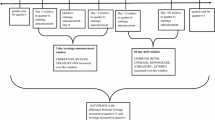Abstract
Using a sample of closed-end equity funds listed on the NYSE from 1994 to 1999, we investigate differences in spreads and adverse selection costs between the closed-end funds and a matched sample of common stocks. We find that spreads and adverse selection costs for the closed-end funds are significantly lower than those of control stocks. The results are consistent for the subperiods both before and after the minimum tick size change on NYSE on June 24, 1997. The differences of spreads and adverse selection costs cannot be attributed to the differences in the characteristics of the closed-end funds and the matched sample of common stocks. Lastly, we find that abnormal investor sentiment and adverse selection costs of closed-end funds are positively correlated over time.
Similar content being viewed by others
References
Anshuman, V. R. and A. Kalay, “Market Making with Discrete Prices. ” Review of Financial Studies 11, 81–109 (1998).
Bacidore, J. M., “The Impact of Decimalization on Market Quality: An Empirical Investigation of the Toronto Stock Exchange. ” Journal of Financial Intermediation 6, 92–120 (1997).
Bacidore, J. M. and G. Sofianos, “Liquidity Provisions and Specialist Trading in NYSE-Listed Non-U.S. Stocks. ” Journal of Financial Economics 63, 133–158 (2002).
Bessembinder, H., “Tick Size, Spreads, and Liquidity:AnAnalysis of Nasdaq SecuritiesTrading NearTen Dollars. ” Journal of Financial Intermediation 9, 213–239 (2000).
Bollen, N. P. B., and R. E. Whaley, “Are ‘Teenies’ Better?” Journal of Portfolio Management 25, 10–24 (1998).
Brown, G. W., “Volatility, Sentiment, and Noise Traders. ” Financial Analyst Journal 55(2), 82–90 (1999).
Brown, G.W. and M. T. Cliff, “Investor Sentiment and the Near-Term Stock Market. ” Journal of Empirical Finance (2003) forthcoming.
Clarke, J. and K. Shastri, “Adverse Selection Costs and Closed-End Funds. ” Working Paper, University of Pittsburgh, (2001).
Christie, W. G. and R. D. Huang, “Market Structure and Liquidity: A Transactions Data Study of Exchange Listings. ” Journal of Financial Intermediation 3, 300–326 (1994).
DeLong, J. B., A. Shleifer, L. Summers and R. Waldmann, “Noise Trader Risk in Financial Markets. ” Journal of Political Economy 98, 703–738 (1990).
George, T. J., G. Kaul and M. Nimalendran, “Estimation of the Bid-Ask Spread and its Components: A New Approach. ” Review of Financial Studies 4, 623–656 (1991).
Glosten, L. R. and L. E. Harris, “Estimating the Components of the Bid-Ask Spread. ” Journal of Financial Economics 21, 123–142 (1988).
Goldstein, M. A. and K. A. Kavajecz, “Eighths, Sixteenths, and Market Depth: Changes in Tick Size and Liquidity Provision on the NYSE. ” Journal of Financial Economics 56, 125–149 (2000).
Huang, R. D. and H. R. Stoll, “Dealer Versus Auction Markets: A Paired Comparison of Execution Costs on NASDAQ and the NYSE. ” Journal of Financial Economics 41, 313–357 (1996).
Huang, R. D. and H. R. Stoll, “Market Microstructure and Stock Return Predictions. ” Review of Financial Studies 7, 179–213 (1994).
Jones, C. M. and M. L. Lipson, “Sixteenths: Direct Evidence on Institutional Execution Costs. ” Journal of Financial Economics 59, 253–278 (2001).
Lee, C. M. C., B. Mucklow and M. J. Ready, “Spreads, Depths, and the Impact of Earnings Information: Intraday Analysis. ” Review of Financial Studies 6, 345–374 (1993).
Lee, C. M. C. and M. J. Ready, “Inferring Trade Direction from Intraday Data. ” Journal of Finance 46, 733–746 (1991).
Lee, C. M. C., A. Shleifer and R. H. Thaler, “Investor Sentiment and the Closed-end Fund Puzzle. ” Journal of Finance 46, 75–109 (1991).
Lee, W., C. Jiang and D. Indro, “Stock Market Volatility, Risk Premium and the Role of Investor Sentiment. ” Journal of Banking and Finance 26(12), 2277–2299 (2002).
Lin, J.-C., G. C. Sanger and G. G. Booth, “Trade Size and Components of the Bid-Ask Spread. ” Review of Financial Studies 8, 1153–1183 (1995).
Muscarella, C. J. and M. R. Vetsuypens, “Stock Splits: Signaling or Liquidity? The case of ADR ‘solo-splits.’ Journal of Financial Economics 42, 3–26 (1996).
Neal, R. and S. M. Wheatley, “Adverse Selection and Bid-Ask Spreads: Evidence from Closed-End Funds. ” Journal of Financial Markets 1, 121–149 (1998).
Schultz, P., “Stock Splits, Tick Size and Sponsorship. ” Journal of Finance 55, 429–450 (2000).
Sias, R. W., “Price Pressure and the Role of Institutional Investors in Closed-Endfunds. ” Journal of Financial Research 20, 211–229 (1997).
Van Ness, B. F., R. A. Van Ness and R. S. Warr, “HowWell Do Adverse Selection Components Measure Adverse Selection?” Financial Management 30, 77–98 (2001).
Weiss, K., “The Post-Offering Price Performance of Closed-End Funds. ” Financial Management 18, 57–67 (1989).
Author information
Authors and Affiliations
Corresponding author
Rights and permissions
About this article
Cite this article
Chen, JH., Jiang, C.X., Kim, JC. et al. Bid-Ask Spreads, Information Asymmetry, and Abnormal Investor Sentiment: Evidence from Closed-End Funds. Review of Quantitative Finance and Accounting 21, 303–321 (2003). https://doi.org/10.1023/B:REQU.0000004781.54733.67
Issue Date:
DOI: https://doi.org/10.1023/B:REQU.0000004781.54733.67




